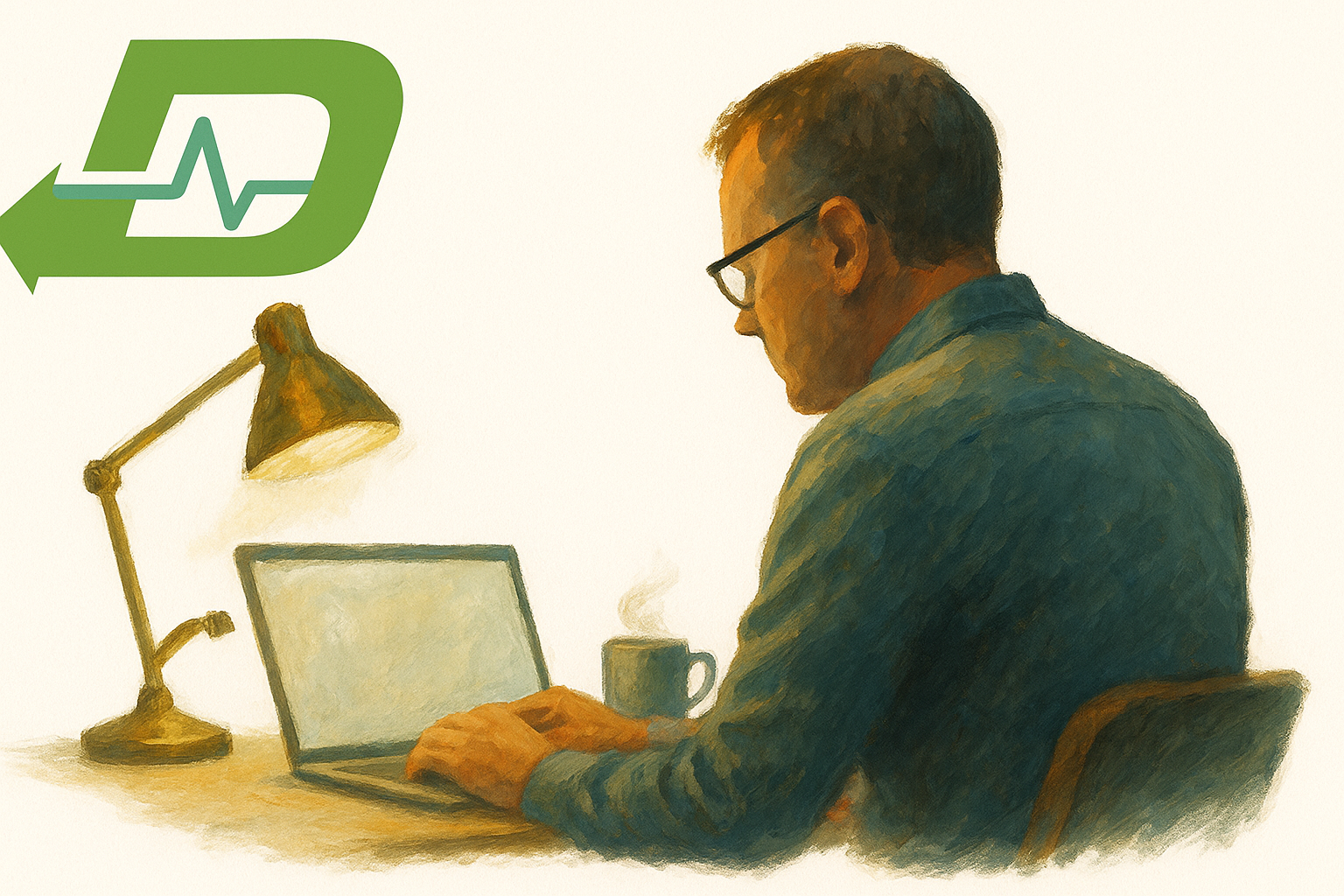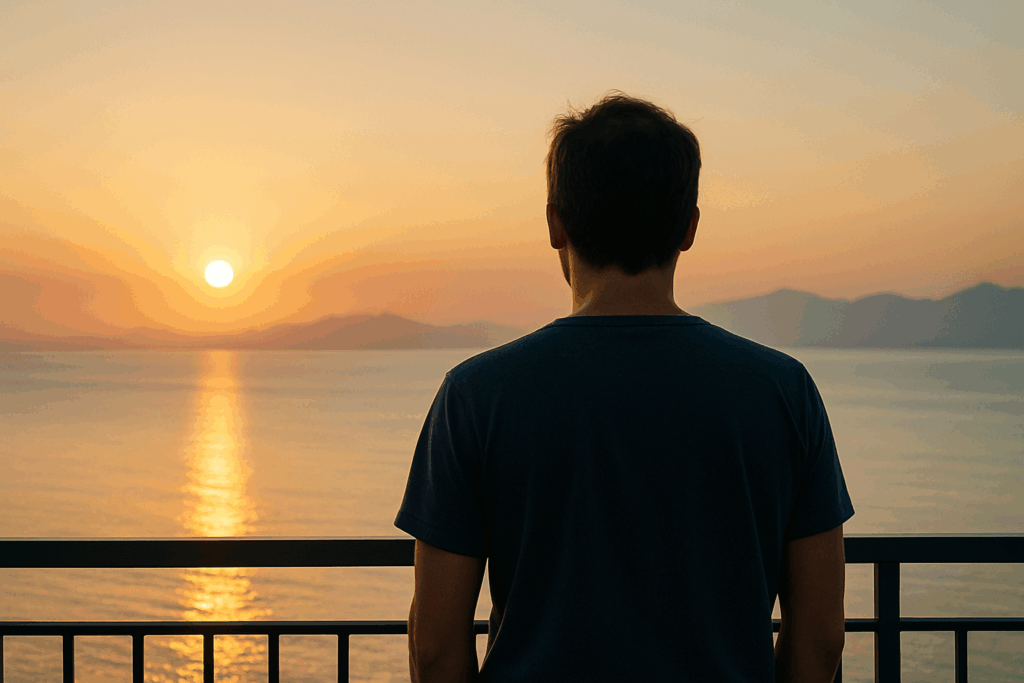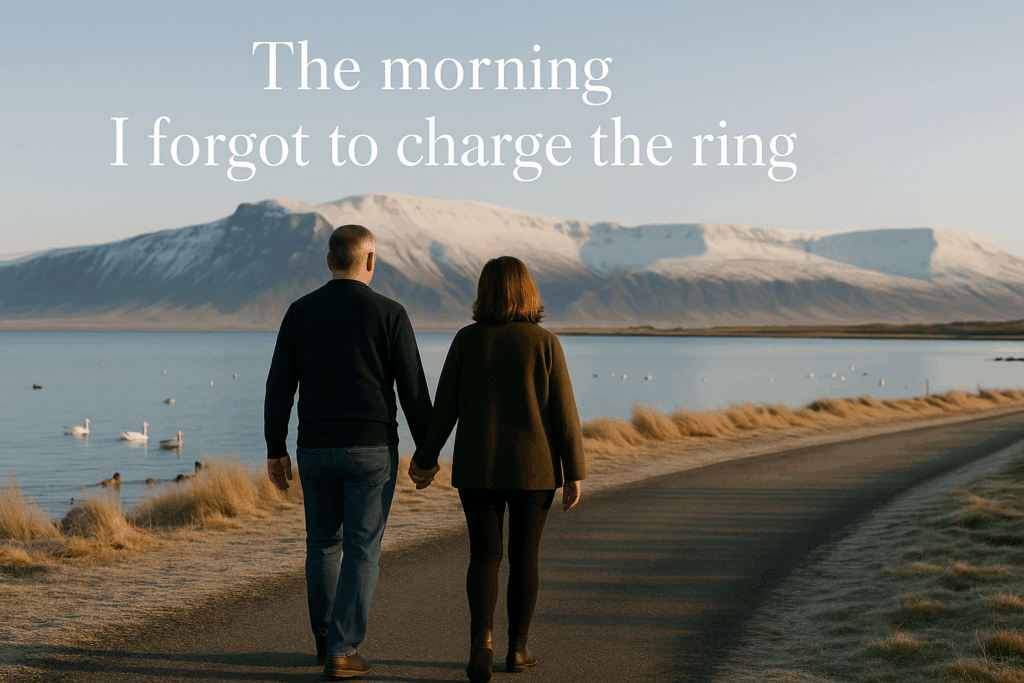Estimated reading time: 9 minutes
You can listen to this article — Orthosomnia: A Wellness Disorder by Design — narrated in full. Whether you’re walking, driving, or just prefer to hear it aloud, click play below
It’s 2:43 a.m. The sky outside is still pale blue—brighter than it should be. Where I live, the summer nights don’t darken; they soften. The sun skims the horizon but never fully disappears.
I stand on the balcony, watching the mountains dissolve into the sea. A bird calls once, then goes silent. Nothing moves, yet the world hums like it forgot to go to bed. I used to wear a smartwatch, but it was too bulky for sleep. So I went with a ring instead—sleek, silent, and always watching.
This used to be a comforting hour. The sea barely breathing, the sky a soft blur between dusk and dawn, as if nature itself had forgotten to sleep. I’d watch the night pretend to be day. But now, even this moment feels like a metric. I don’t enjoy it—I audit it.
I think about circadian misalignment, about melatonin suppression, about how this lovely, glowing horizon is probably shaving points off my recovery score. I don’t ask myself how I feel. I refresh the app and wait for the verdict.
The Score
I remember the first time the number got to me.
I had slept fine—or so I thought. No tossing, no turning. I woke up with sunlight brushing the floor and that floaty feeling that follows a good night. But the app disagreed.
Sleep Score: 67. Recovery: Low. Heart rate variability: mediocre. Deep sleep: below target.
Within minutes, I felt off. Tired, maybe. A little foggy. But was I really? Or was I just interpreting the day through the lens of a number?
I started second-guessing myself. Maybe I hadn’t slept that well. Perhaps that ache in my shoulder wasn’t from golf but from something more systemic. The worst part? I hadn’t noticed anything wrong until the app told me.
It’s strange how quickly something natural becomes something to manage. Sleep—once as effortless as breathing—was now something to optimize, track, refine. A nightly performance with metrics, scores, and expectations. I wasn’t just resting; I was trying to ace something meant to be effortless.
The tools made it worse. Sleek interfaces, graphs, little badges of achievement—”3 nights of high recovery in a row!”—all designed to look like health, but feel like judgment.
I didn’t set out to ruin sleep. I just wanted to sleep better.
Optimization
The changes started small.
No caffeine after 2 p.m. Then noon. Then none. I adjusted my evening light. I stopped watching anything with a plot after 8. Blue-light glasses. Magnesium. Glycine. L-theanine. I downloaded four meditation apps but couldn’t decide which voice sounded least like it belonged in a shampoo commercial.
We used to end the day together, talking, watching a Netflix series side by side. That little ritual meant nothing on a spreadsheet, but everything in real life. Now I disappeared into my wind-down routine by 8:30. Screens off. Lights dimmed. Supplements lined up like little sentries. She stayed behind with her book. I sat in the dark, trying to lower my heart rate.
“Do you really need to look like a hostage to get some rest?” she joked once.
I smiled, but I didn’t answer. Because I wasn’t sure it was a joke.
Eventually, we stopped going to bed at the same time. My schedule was too rigid. She liked to read. I said the light disrupted melatonin. She offered to use a Kindle. I said the spectrum was still too blue.
I started sleeping in the guest room. I said I’d do it temporarily, just until I got back on track.
But I wasn’t off track. I was chasing a number.
I was managing recovery. I was investing in longevity. I was… alone
The Drop
I did everything right.
No screens after seven. Dinner at six—wild salmon, broccoli, no starch. Magnesium, glycine, tart cherry juice, and ashwagandha. Blue-light glasses. Breathwork. Gratitude journaling. The bedroom is at 18°C, blackout curtains sealed like an operating room. No pets. No partner. No sound.
I even remembered to tape my mouth shut.
I fell asleep easily. Dreamed of something soft and woke up clear. For a moment, I thought: maybe I’ve cracked it.
Then I opened the app.
Sleep Score: 58. Recovery: Low. Deep Sleep: Critically insufficient.
I refreshed the screen. Closed the app. Reopened. Nothing changed. I stared at the graph. REM too short. Heart rate dipped too slowly. The HRV curve looked like it had performance anxiety. I ran diagnostics: Was the ring too loose? Did I breathe wrong? Too hydrated? Not enough?
I felt rested. Until I didn’t. I wasn’t foggy until I acted like I was. I skipped my walk. Declined a call. I told myself I was “protecting my nervous system.”
Really, I was obeying the algorithm.
It wasn’t insomnia. I was sleeping fine. I just couldn’t stop grading it.
The Spiral
After that night, things got… professional.
I didn’t go to bed. I executed a sleep protocol: supplements, red lights, and environmental silence. Sleep wasn’t rest—it was a controlled experiment.
I talked about “sleep windows.” Referred to Netflix as a stimulant. Said things like “sympathetic activation” with a straight face.
Small pleasures became tactical errors. Dinner after 8? Sabotage. Wine? Liquid cortisol. Arguments? Risk factor for disrupted delta waves.
I adjusted everything: meals, movement, light, sound. Even my dog looked worried.
Each morning I opened the app like a stock portfolio. Green? Invincible. Yellow? Functional. Red? Better cancel life.
Once, I canceled a hike because my ring said recovery was low. Never mind that I felt fine. The score was 59. The mountain could wait.
When I felt tired, I didn’t know if it was poor sleep or the mental gymnastics of managing it.
To others, I looked disciplined. Optimized. They had no idea how much effort it takes to fall apart so efficiently.
The Diagnosis
It came to me, like most modern diagnoses, in a late-night scroll.
The headline read:
Are You Sleeping Worse Because You’re Trying Too Hard? Meet Orthosomnia.
I blinked. Ortho-what?
I clicked. Skimmed. Slowed down. It was all there.
People who sleep fine until they start tracking it. People who feel rested but don’t score well. People who rearrange their lives to serve the data.
I lowered my phone, mouth taped shut. Oh no, I thought. It’s me.
Apparently, this was real. Orthosomnia: a sleep disorder caused by trying to sleep perfectly. A disorder invented by the cure. I wanted to laugh. I wanted to be offended. Mostly, I wanted to throw the ring into the sea. I didn’t.
I bookmarked the article. Then, I reopened the dashboard. Recovery: 64. Readiness: Fair. Deep sleep: meh.
Even with the diagnosis, I felt that familiar tug: maybe tonight will be better.
Naming the Beast
You’d think naming something would make it easier to release.
It didn’t.
It made it feel more official. Like a condition I now needed to manage.
I knew I was over-correcting. But now that it had a name, I had a reason to keep tracking it.
That’s the trap. Even when you know you’re caught, you still want the numbers to improve.
I read about people who stopped using trackers and learned to trust their bodies. I admired them. I did not join them.
Because knowing you’re obsessed doesn’t make it easier to stop. Sometimes it just gives the obsession a name—and permission to stay.
The Cure
Recovery didn’t come in a single moment. It came from forgetting.
Forgetting to charge the ring. Forgetting where the charger even was. Forgetting to open the app.
At first, I panicked. I woke up and reached for the data—and found nothing. No score. No graph. No verdict. I felt… unmoored. Like I’d skipped a ritual and tempted fate. But nothing happened. We drank our coffee. We went for a walk. The sky looked particularly wide that morning.
The notifications stopped. The dashboard stayed dark. I slept without knowing how well I slept—and I survived it. Actually, I did more than survive. I felt better.
I started doing things I’d ruled out. Watching a movie late. Laughing after 10. Reading in bed with someone beside me. Letting myself get sleepy instead of trying to induce sleep. I drank coffee at 3 p.m. with no apologies. I skipped supplements. Some nights I even forgot to do breathwork—and didn’t wake up broken.
One night, I fell asleep in my clothes with the window open. No tape. No supplements. No score. And I slept well. Or maybe I didn’t. I didn’t check. I just woke up. I stretched. I breathed. I let the day begin without a report card.
And I stopped sleeping alone.
Nothing dramatic had changed. Just… everything.
Epilogue: Whiteout
It’s mid-morning, though it could be midnight. The snow has erased everything outside—sky, sea, hills. Just white. A stillness that doesn’t ask to be measured.
There’s nothing to look at. No graph. No glow. No signal. Just silence.
I don’t know what time it is. I haven’t checked.
I might sleep well tonight. I might not.
But I’ll wake up. I’ll stretch. I’ll breathe. I’ll feel what I feel—before anyone tells me how I’m supposed to.
And that, I’ve decided, is enough.
Author’s Note
This essay was sparked by a 2025 Salon article titled “Obsessed with getting good sleep? That could be making it worse.” It told the story of a man who slept fine—until his smartwatch said otherwise. He finally took it off to save his sanity.
It made me realize: this isn’t rare. More and more, we micromanage our sleep the way others obsess over step counts or stock prices. And in the process, something essential slips away.
According to a 2023 survey by the American Academy of Sleep Medicine, about a third of Americans have used a sleep tracker. Of those, nearly 70% changed their behavior based on what the data told them.
And yet, the data isn’t always right. The devices are imprecise, the metrics debatable—and for some, the result isn’t better sleep, but more stress, more self-surveillance, and, ironically, less rest. Optimization, it turns out, doesn’t always make things better. Sometimes it just makes them louder.
Though this story is written in the first person, it isn’t about me. Not exactly. It’s a composite—of strangers, studies, overheard conversations, and the quiet ache of a culture that can’t stop optimizing. I just gave it a name and a voice. The rest, you probably already know by heart.
The term orthosomnia was originally coined in a 2017 study published in the Journal of Clinical Sleep Medicine, which you can read here.
And finally, it’s worth remembering that “wellness” has quietly morphed into capitalism’s most soothing disguise. What once meant wholeness or peace now comes packaged in subscription models, push notifications, and influencer codes for sleep gummies. The industry doesn’t just promise health—it sells the anxiety of not having enough of it.
There are no limits. Your gut, your cortisol, your mitochondria, your aura—everything’s a market now. You can optimize your morning, hack your hormones, and meditate under a $500 infrared blanket. And still wake up feeling vaguely behind.
Wellness used to mean being okay. Now it means being in pursuit – forever.



Brilliant article … its so true how easily we can fall down the rabbit data hole … I do tend to focus on my Garmin and Strava data, post run … but have not fallen that deep (yet) re sleep and HRV data … although I do use my HRV score as an leading and lagging indicator for over training, etc … but love reading in bed, falling asleep watching netflix and don’t have curtains on our windows .. and love sleeping with my wife and the dogs and cats moving around … 🙂 ..always love your articles .. keep them coming
Thanks so much Mike! Really appreciate your kind words — and I love your take on keeping things human amid all the data. Glad the article resonated. More on the way.
Hi Axel, Great I enjoy your insights … and wide range of topics – also loved your article on reading medical studies (aligns with a presentation I did many years ago on how to read medical/science papers for dummies) and your few recent ones on cardiac, LDL etc ..
Regards
Mike
One thing experts say about sleep is that the bedroom should be used for sleeping, not for reading, TV, etc.
I’ll also warn about Strava data. I recently discovered on their Android app that it was recording data while I was sitting on a bench resting and not moving. I don’t manually pause the app while resting as it is the moving time and BPM that I am most interested in.
But I accumulated distance while sitting there and watched my “speed” change every second! [lol] I have a support incident open but haven’t been impressed with Strava support in the past, so unsure if they will call this a “feature” rather than a “bug”. I now have to wonder if this explains why measured distances are often recorded as longer under Strava an dhow long this has been going on but I just never noticed.
Jojo
Thank you for the insights! You’re absolutely right about the importance of reserving the bedroom for sleep—something that’s often overlooked in our tech-filled routines.
And that Strava story is fascinating (and a bit troubling)! It’s surprising how even small inaccuracies in fitness tracking apps can go unnoticed for a long time—and then quietly distort our perception of progress. What you describe could definitely explain why Strava sometimes reports longer distances. Whether it’s a bug or a “creative interpretation of movement,” it’s a good reminder that even our most trusted metrics sometimes need a second look. Appreciate you sharing it!